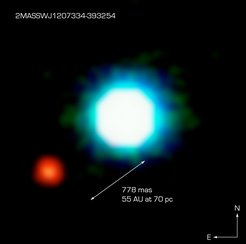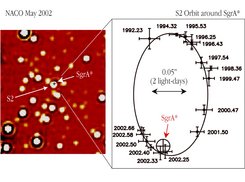The stars no longer twinkle
Adaptive optics technology at the Very Large Telescope has revolutionized the astronomical observation techniques
Ten years ago today, NACO became operational: the first adaptive optics system of ESO's Very Large Telescope (VLT). Adaptive Optics allows astronomers to remove the stars' twinkling – disturbances due to the Earth's atmosphere –, allowing for extremely sharp images of celestial objects. NACO looks back on a decade of scientific results, including the first direct image of an exoplanet and insight into the surroundings of our home galaxy's central black hole.

For non-astronomers, the twinkling of the stars can be quite romantic. For astronomers, it is the outward sign of a fundamental problem: As light passes through turbulent areas of the Earth's atmosphere, it is deflected in uneven and ever-changing ways. What should be a sharp image of, say, a star in a telescope instead becomes a diffuse disk as the star's image dances to and fro, or splits into several partial images. That is why, before adaptive optics, astronomers were forced to use space telescopes or else to wait for exceptionally good atmospheric conditions – which happen only a few times, if at all, in any given year – to obtain sharp images of celestial objects.
At least for images in the near-infrared, at slightly longer wavelengths that those of visible light, astronomers can also address the problem directly, using Adaptive Optics (AO): The ever-changing image is analysed by a fast computer which, in real time, controls a deformable mirror. As the image dances and splits, the mirror twists warps and to compensate, restoring sharpness.

The NACO instrument was the first Adaptive Optics system at the VLT, the flagship facility for European ground-based astronomy. Installed on one of the VLT's four 8.2 metre telescopes in 2001, it commenced scientific operations ("first light" in astronomical parlance) on November 25, 2001.
NACO was not the first AO instrument on an 8-10 metre class telescope, but it is arguably one of the most successful ones. With its help, the VLT immediately achieved a resolution surpassing that of the Hubble Space Telescope – at least at infrared wavelengths, where NACO operates. Scientific results from NACO run the gamut from solar system research to the most distant galaxies.

The instrument revealed the infrared glow of individual volcanoes on Jupiter's moon Io, and obtained some of the first detailed surface and weather maps of Saturn's largest moon, Titan. It also excelled at detecting and examining planets outside the solar system (exoplanets): A faint speck of light called 2M1207b was the first planet-sized object ever imaged in orbit around an object other than the Sun (in this case, a so-called brown dwarf – an object that is not quite a star, but larger than a planet).
In another first, NACO performed the first spectral analysis of a directly imaged exoplanet in orbit around a nearby star. This allowed astronomers to probe the atmosphere of the exoplanet HR 8799c for the presence of methane and carbon monoxide.
NACO's uniquely sharp infrared view also pierced the dust veil hiding the centre of the Milky Way. By tracing the orbit of a star around the Galactic center, NACO provided the strongest evidence yet for the presence of a central black hole in the centre of our home galaxy, with the mass of several million Suns.
When it came to young star clusters like the Arches cluster or RCW 38, NACO proved its worth by imaging separately hundreds of densely packed stars in the clusters' central regions. This provided astronomers with data to study the early phases of stellar evolution over the entire range of stellar masses, from stars with less than tenths of the mass of our Sun to stars with more than 100 solar masses.
NACO is a first generation VLT instrument, developed in a joint effort between French and German research institutes and ESO. Thanks to continuous upgrades over the past decade, it remains one of the preeminent Adaptive Optics instruments worldwide, enabling European astronomers to stay at the forefront of astronomical research. Several additional Adaptive Optics instruments have entered service at the VLT over the past decade. A number of new instruments are currently under development, and Adaptive Optics will be an integral part of the next generation of telescopes, including the 40 metre class European Extremely Large Telescope.
Background information

NACO is a first generation VLT instrument, developed in a joint effort between French and German research institutes and ESO. NACO is short for NAOS-CONICA, which acronyms in turn stand for the instrument's two sub-systems:
The Nasmyth Adaptive Optics System (NAOS) has been developed, with the support of Institut National des Sciences de lUnivers/Centre National de la Recherche Scientifique (INSU/CNRS) by a French Consortium in collaboration with ESO. The French consortium consists of Office National d'Etudes et de Recherches Aèrospatiales (ONERA), Institut de Planetologie et d'Astrophysique de Grenoble (IPAG, formerly called Laboratoire d'Astrophysique de Grenoble) and Observatoire de Paris: Laboratoire d'études spatiales et d'instrumentation en astrophysique (LESIA, formerly called DESPA) and DASGAL (which does not exist anymore). The Project Manager is Gérard Rousset (ONERA), the Instrument Scientist responsible is François Lacombe (Observatoire de Paris) and the Project Scientist is Anne-Marie Lagrange (Institut de Planetologie et d'Astrophysique de Grenoble, OSUG, Université Joseph Fourier/CNRS).
The CONICA Near-Infrared CAmera has been developed by a German Consortium, with an extensive ESO collaboration. The Consortium consists of the Max Planck Institute for Astronomy (MPIA) (Heidelberg) and the Max Planck Institute for Extraterrestrial Physics (MPE) (Garching). The Principal Investigator (PI) is Rainer Lenzen (MPIA), with Reiner Hofmann (MPE) as Co-Investigator.
MP/HOR















